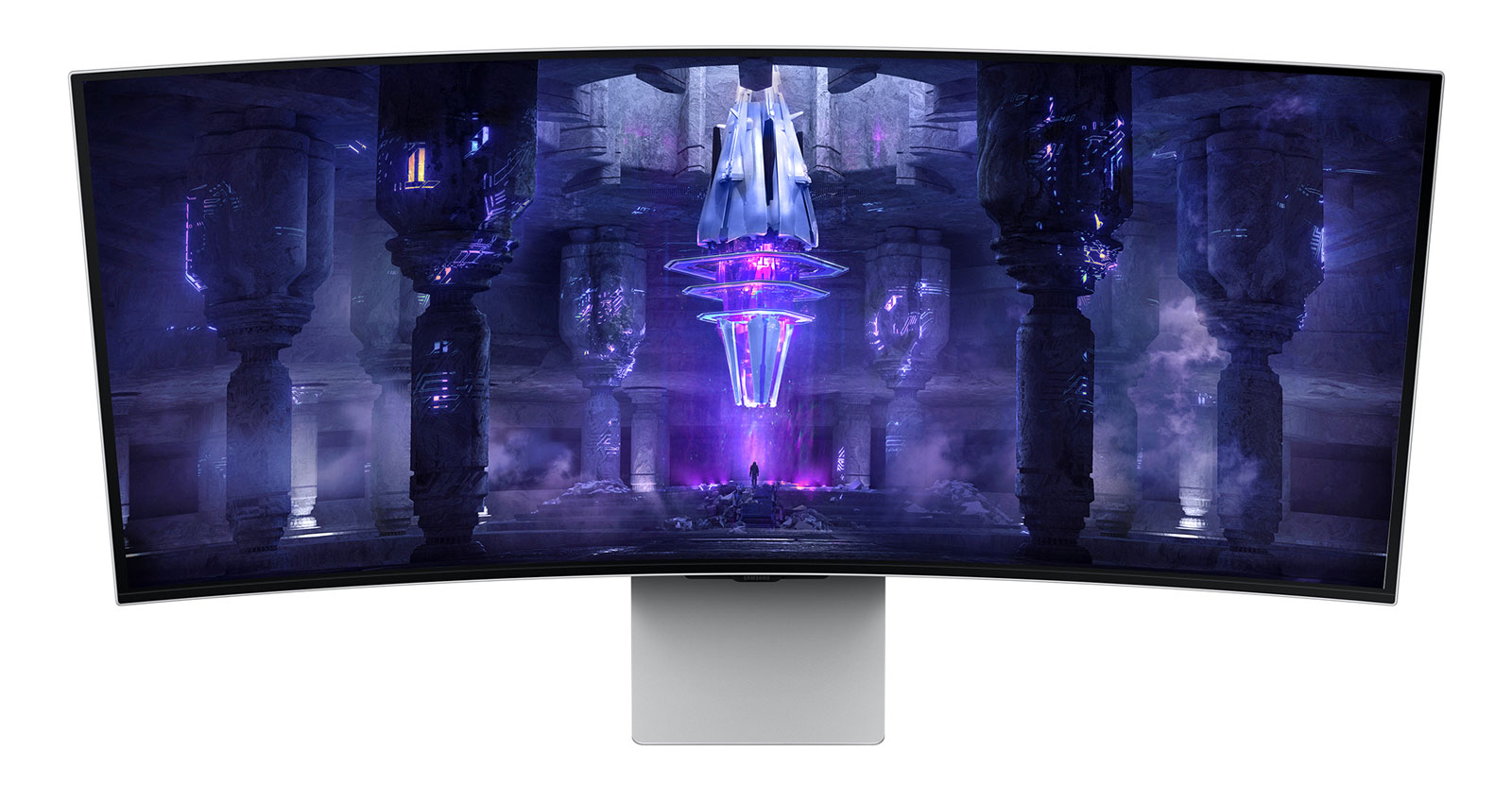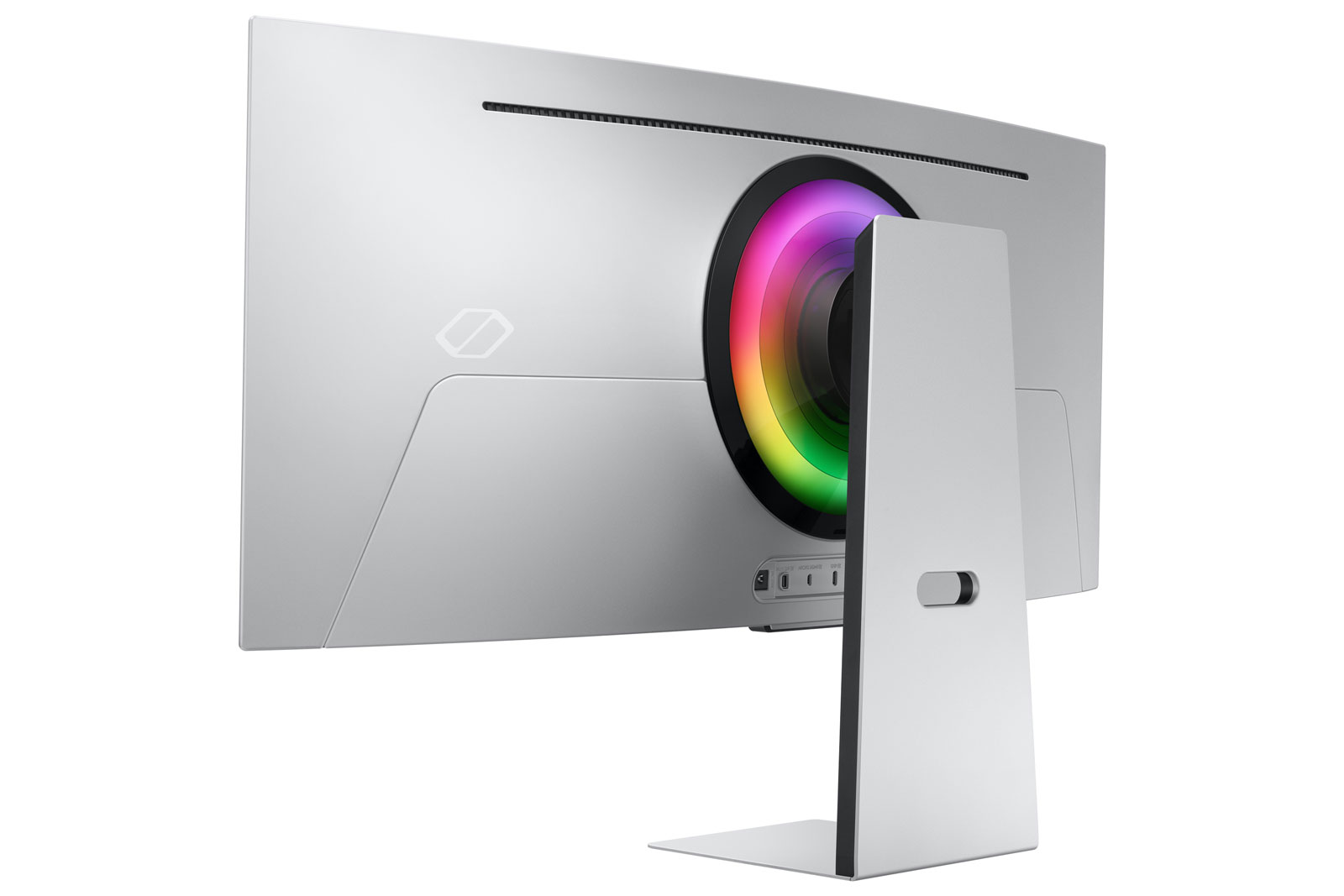Samsung's First OLED Gaming Monitor Will Launch in Q4 2022
The 34-inch curved display leverages Samsung's QD-OLED technology
Samsung has announced its first OLED gaming monitor, which will be unveiled at the IFA 2022 show in Berlin on Sept. 2. The new Samsung Odyssey OLED G8 Gaming Monitor (G85SB) is a curved ultra-thin 34-inch monitor with a 21:9 aspect ratio and a 3,440 x 1,440 resolution.
We don't have the full specs yet, but Samsung highlighted some of the more exciting aspects of the monitor, including a 175 Hz max refresh rate, a 0.1ms response rate, and a thickness of just 3.9mm (0.15 inches) at its thinnest part. The monitor is also VESA DisplayHDR 400 True Black certified and covers 99.3% of the DCI-P3 color gamut.
The 34-inch curved panel has 1800R curvature and mixes Quantum Dot (QD) and OLED technology for ultra-vivid color, as well as the fast image response and dense, dark black for which OLED technology is renowned. Samsung quotes the Odyssey OLED G8's contrast ratio as 1,000,000:1, thanks to the individual pixel lighting characteristics of OLED displays. Samsung reframes this statistic by calling it a "near-infinite" contrast ratio.
The Odyssey OLED G8 is advertised as a gaming monitor first and foremost. It supports AMD FreeSync Premium, but no specific mention of Nvidia G-Sync support was mentioned in today's press release. Other Samsung Odyssey gaming monitors we've looked at, such as the 49-Inch Odyssey G9, also come with gaming features such as genre presets; this model should, too.
Gamers might also appreciate the Odyssey OLED G8’s built-in ambient/surround lighting. Samsung says it has upgraded the Odyssey portfolio’s CoreSync & Core Lighting+ for this new monitor. The lighting can be used for various effects, including syncing with on-screen action for a more immersive experience.
While it is classed as a gaming monitor, the Odyssey OLED G8 has a lot of smart TV style features — and, thanks to Samsung Gaming Hub, you will be able to use it without a PC to play games via popular streaming services. The built-in IoT hub will let users stream video and also check-in/interact with smart home devices. There must be some built-in Ethernet/Wi-Fi networking for these standalone streaming features, but Samsung mentions nothing specific.
The monitor has Micro HDMI (2.1), Mini DP (1.3, and USB-C ports. These mini ports make sense, as the Odyssey OLED G8 is extremely slim. However, Samsung has still found room to include a pair of "crisp" 5W speakers. The monitor comes with a stand that is tilts and is height-adjustable.
Get Tom's Hardware's best news and in-depth reviews, straight to your inbox.
According to Samsung, the Odyssey OLED G8 will be available globally from Q4 2022, but did not reveal a specific date or pricing.
It's looking like Q3 2022 is the quarter in which OLED gaming monitors finally take off. Other OLED gaming monitors/TVs launched in the last week include the 42-inch LG LX3 bendable TV, the 45-inch LG UltraGear gaming monitor, and the 45-inch Corsair Xeneon Flex 45WQHD240 OLED bendable monitor.

Mark Tyson is a news editor at Tom's Hardware. He enjoys covering the full breadth of PC tech; from business and semiconductor design to products approaching the edge of reason.
-
Metteec An obvious comparison with the new Samsung G8QNB is the Alienware AW3423DW, the first commercially available QD-OLED monitor, that uses the same Samsung panel. A few things that could make a significant difference:Reply
The generation of GSYNC/FreeSync is important. The AW3423DW GSYNC ultimate chip is not able to deliver 10-bit color at 175 Hz. You need to reduce to 144 Hz to get 10-bit; however, most people do not notice a difference on this monitor between 10-bit @ 144 Hz versus 8-bit @ 175 Hz;
Smaller footprint could be helpful. The AW3423DW is not as heavy as IPS panels, but still takes up a lot of desk space.
Screen coating on the AW3423DW absorbs light, and in bright conditions, blacks can appear grey. If Samsung uses polarized coating, like on its C9, the G8QNB could be superior in bright conditions.
G8QNB's built-in speakers are a nice touch.
Alienware offers an industry leading 3-year burn-in protection/advanced replacement warranty on the AW3423DW. OLED TVs of yesterday experienced horrible burn-in problems. Samsung typically offers 1-year warranty.
The Alienware AW3423DW starts at $1,299 plus tax and shipping. I would imagine Samsung's offering would be at or less than the Alienware. -
court655 I for one am sorely disappointed. Why go backward but instill next-gen tech? Not even 4k or 5k, a mere 34inch while they make gaming ultra wides at 49". I guess affordability? But let's face it, it's gonna be pricey all the same. Not sure what the plan was behind this.Reply -
-Fran- Why do I want "smart" features when it's meant to be attached to a friggen' PC.Reply
SAMSUNG, COME ON. STOP!
I like my peripherals as dumb as possible to cut the price and fat. Specially when you try to add as many tracking stupidity as you already do.
Regards. -
UnCertainty08 Replycourt655 said:I for one am sorely disappointed. Why go backward but instill next-gen tech? Not even 4k or 5k, a mere 34inch while they make gaming ultra wides at 49". I guess affordability? But let's face it, it's gonna be pricey all the same. Not sure what the plan was behind this.
I am also sorely disappointed.
Why did they choose 1440?
I have C49RG90, the model prior to the G9, 49" ultra wide 5120x1440.
I also have QN90A 55" 4K.
I was really looking forward to this monitor until I saw the resolution.
Samsung could have released a great product. -
thestryker ReplyMetteec said:An obvious comparison with the new Samsung G8QNB is the Alienware AW3423DW, the first commercially available QD-OLED monitor, that uses the same Samsung panel. A few things that could make a significant difference:
The generation of GSYNC/FreeSync is important. The AW3423DW GSYNC ultimate chip is not able to deliver 10-bit color at 175 Hz. You need to reduce to 144 Hz to get 10-bit; however, most people do not notice a difference on this monitor between 10-bit @ 144 Hz versus 8-bit @ 175 Hz;
Smaller footprint could be helpful. The AW3423DW is not as heavy as IPS panels, but still takes up a lot of desk space.
Screen coating on the AW3423DW absorbs light, and in bright conditions, blacks can appear grey. If Samsung uses polarized coating, like on its C9, the G8QNB could be superior in bright conditions.
G8QNB's built-in speakers are a nice touch.
Alienware offers an industry leading 3-year burn-in protection/advanced replacement warranty on the AW3423DW. OLED TVs of yesterday experienced horrible burn-in problems. Samsung typically offers 1-year warranty.
The Alienware AW3423DW starts at $1,299 plus tax and shipping. I would imagine Samsung's offering would be at or less than the Alienware.
The other difference is that by not having the GSYNC module the power consumption, especially in low power modes, ought to be a fair bit lower. The fact that this has an 1800R curve unlike Samsung's standard 1000R makes me pretty happy.
I'm not in the market for a new display yet, but these two are certainly towards the top of what I would want. -
tennis2 Disappointed that we're going to (seemingly) go 6+ months with just a single 34" 21:9 QD-OLED panel on the market. Supposedly just to absorb/pad the high cost, but 27" and 32" monitors are still the most common. What do you suppose a 27" 16:9 QD-OLED would cost?Reply
I HATE the recently released 1000R curvature. -
tennis2 Reply
Does the AW3423DW actually have a GSync ultimate module inside? Haven't heard much/anything about those in quite a few years. Especially little mention since Nvidia started supporting VESA Adaptive Sync. Does the GSU module (alone) still cost ~$500? Not sure if the GSync Ultimate and GSync HDR modules are the same, or if there's 3 different GSync modules now. Kindof assumed GSync modules weren't being included in any new monitors since the January 2019 Adaptive Sync adoption.Metteec said:The AW3423DW GSYNC ultimate chip is not able to deliver 10-bit color at 175 Hz. You need to reduce to 144 Hz to get 10-bit; however, most people do not notice a difference on this monitor between 10-bit @ 144 Hz versus 8-bit @ 175 Hz;
https://pcper.com/2018/06/asus-rog-swift-pg27uq-27-4k-144hz-g-sync-monitor-true-hdr-arrives-on-the-desktop/
I wouldn't be surprised to see that this FPGA alone makes up $500 of the final price point of these new displays, let alone the costly DDR4 memory.
-
TMRichard Holy dickens, why the hell can't we just have a nice, 4K OLED, 27-28" 16:9 panel. I don't want or need Ultra Wide, bendable, smart - Just a nice, plain, flat, 4K, 120Hz, OLED panel.Reply -
Metteec The AW3423DW does have a G-SYNC Ultimate module. Some users complain of noticeable fan noise from the module, but my experience is my tower produces louder ambient noise that makes the monitor's fan unnoticeable. Edit: There is a significant cost for G-SYNC Ultimate module, though it is difficult to quantify. The $500 figure was from 2018, though I see $200 premium from G-SYNC Ultimate to FreeSync monitors of similar caliber. Reference the Acer CP7271K GSYNC Ultimate versus the Acer XV273K FreeSync, both 27" 4K @ 144Hz at $699 and $459, respectively.Reply
The 27-28" 4K monitor market is too crowded with $300-$400 devices. Samsung made significant progress in increasing yields of its QD-OLED panels, but they are still low, and the costs still high. I doubt many would be willing to pay $700+ for a 27" QD-OLED panel right now, which is why Samsung targeted more expensive and larger formats that offer greater margin. However, Samsung will abandon LCD entirely. They intend to manufacture solely QD-OLED panels for TVs and monitors by Q1 2024 (Eun-Jin, Kim. "Samsung Display's QD-OLED Display Production Yield Reaches 85%." Business Korea, 5 Jul. 2022). That is great news for consumers seeking smaller QD-OLED panels, and I would estimate seeing a few available by Q3 2023. We are witnessing a revolution in monitors, with thinner, lighter, and more vibrant displays within reach of most gamers. It is really an exciting time to be a gamer. -
blacknemesist ReplyTMRichard said:Holy dickens, why the hell can't we just have a nice, 4K OLED, 27-28" 16:9 panel. I don't want or need Ultra Wide, bendable, smart - Just a nice, plain, flat, 4K, 120Hz, OLED panel.
LG needs to make a C2-like 32'' and 40'' tailored for PC so burn-in is not an issue and we can all be happy with premium quality for a fair price.

